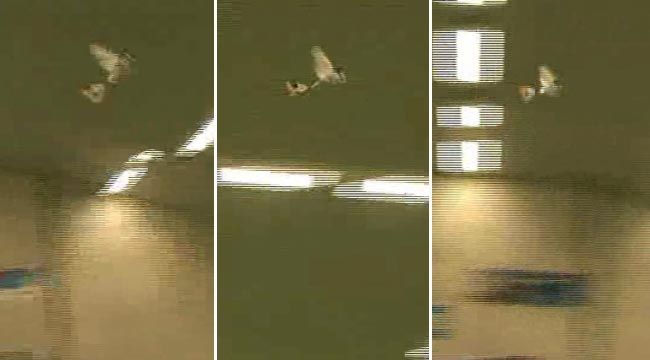World's Smallest Camera Plane Shows Off in Public

It has a 4-inch wingspan and weighs just over 3 grams. It looks like a dragonfly, and its flapping wings make it fly just like one. But it's a man-made aircraft which carries a tiny camera that transmits live video of what it sees — and it is intended to be merely the forerunner of much smaller aerial drones to come.
The DelFly Micro, which its developers say is the world's smallest camera-equipped aircraft, made its public debut today in a sports center at Delft in the Netherlands. The four-man research team from the Delft University of Technology that built the DelfFly Micro presented it to a media audience, conducting the first public demonstration flight of the tiny vehicle.
Team member Bart Remes said he and his colleagues Christophe De Wagter, Guido de Croon and Rick Ruijsink first flew the DelFly Micro on May 5. It represents the third generation of DelFly micro air vehicles (MAVs) developed by the team, coming after the much larger DelFly I that first flew in 2005 and the second-generation DelFly II that flew for the first time in 2006.
The team's primary goal in developing the DelFly family of MAVs has been to investigate the aerodynamics of ornithopters — aircraft that fly by flapping their wings like a bird or insect. The airflows round the thin PET films that make up the MAVs' wings "are so difficult (to model), no computer can simulate them," said Remes. "We can’t do it with calculations, so we can only do measurements."
In the course of its research the team measured the movements of smoke particles over the wings of the 11-inch-span, 16-gram DelFly II, and incorporated force sensors into its wings to determine how much lift the wings generated at different flapping frequencies.
Miniaturization and autonomous flight
The researchers found the ideal wing-flapping frequency for the DelFly II was 14 beats per second, said Remes. The wings of the DelFly Micro, which has a much greater ratio of weight to wing area, need to flap 30 times a second for optimally efficient flight.
Sign up for the Live Science daily newsletter now
Get the world’s most fascinating discoveries delivered straight to your inbox.
In addition to helping the team carry out its research into the aerodynamics of ornithopters, each new DelFly generation has helped achieve other goals of the program. One important goal is to achieve a greater degree of miniaturization with each succeeding generation, and a second is to achieve autonomous flight, said Remes.
So far the DelFly Micro hasn’t flown autonomously: It still has to be flown remotely by a pilot, who juggles the joysticks on a wireless remote-control unit to control the vehicle's flight in response to what he sees on the video feed from the MAV's tiny camera. However, the Micro's predecessor the DelFly II has achieved autonomous flight, said Remes.
After developing improved image-recognition software to allow the DelFly II to analyze its surroundings and recognize its position in relation to them, the team demonstrated autonomous flight with the second-generation aircraft during indoor trials two weeks ago at the EMAV competition in Germany.
"We can copy this on the DelFly Micro," said Remes.
DelFly Micro specs
Made of PET film (used for the wings), balsa wood and carbon, the DelFly Micro is powered by a tiny lithium polymer battery that weighs just 1 gram and generates 30 milliampere hours of power — enough to keep the insect-sized MAV flying for 3 minutes.
Together with its associated transmitter, the DelFly Micro's video camera weighs only about 0.4 grams. The DC brush motor driving its flapping wings weighs 0.45 grams, the two magnetic actuators that operate its directional and elevator rudders weigh 0.5 grams, and its operating electronics 0.2 grams. Another 0.5 grams of structure brings the total weight of the DelFly Micro to 3.07 grams.
Although the DelFly Micro can't fly backwards like the DelFly II that preceded it, the tiny MAV reaches a respectable top speed of 5 meters (16.5 feet) per second.
Theoretically, this would allow the DelFly Micro to travel some 900 meters (3,000 feet), but Remes said the MAV's effective range is at present restricted to about 50 meters (165 feet) by the fact that the signal from its tiny video transmitter is too weak for the simple antenna that the team currently uses to receive the signal at any greater distance.
The range will increase when the team adds a better antenna to its ground control station. Also, when available, new battery technology would make the aircraft more efficient, increasing its flying time well beyond the 3 minutes' duration the DelFly Micro achieves now. Greater endurance potentially would allow MAVs of this size to be used for reconnaissance flights into tight spaces or dangerous terrain, such as partially collapsed buildings or radioactive areas.
Goals for even smaller aircraft
Remarkable though the DelFly Micro is, its builders have even more ambitious plans for subsequent DelFly generations. The Micro was completed about a year into a four-year program to create the DelFly Nano, a MAV that is intended to weigh just 1 gram and to have just a 2-inch wingspan. Its wings will need to flap much more often than the DelFly Micro to keep it flying.
"The Micro is just a testbed," said Remes. "It allows us to do measurements for the Nano. Three years from now, we hope to manage (to fly) this."
But even when the team succeeds in miniaturizing the DelFly Nano's motor, control actuators, camera and electronics enough to fly the moth-sized MAV, it won’t be content.
"The Nano itself will be a testbed," said Remes. "We are dreaming of a MAV the size of a fruit fly. Nature has shown that the aerodynamics are possible. It's possible in theory, but in practice it will be hard. It will take a long time and a lot of research."











